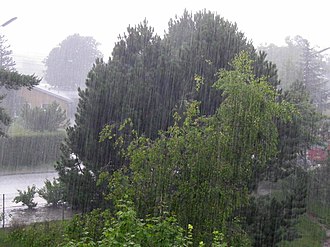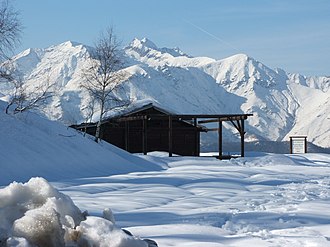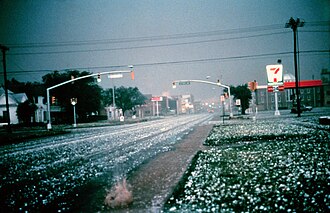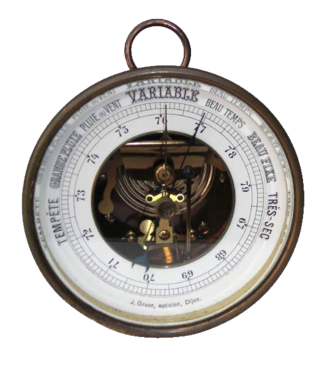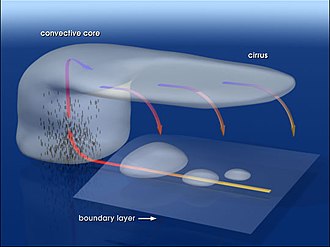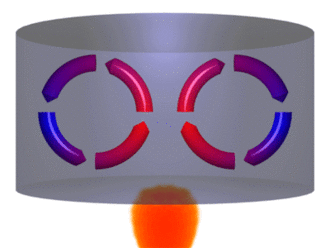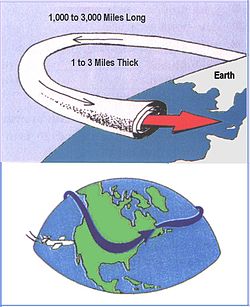AY Honors/Weather/Answer Key
Template:Honor header Template:AY Master
1. Explain how each of the following is formed:
a. Fog
Relative humidity is a measure of how much water is in the air compared to how much water can be in the air. As the temperature rises, the air can hold more water, and as it drops, it can hold less. When the humidity is 100% and the temperature drops, the air can no longer hold all the water that is in it. Fog is moisture that gets squeezed out of the air when the temperature drops.
b. Rain
Rain forms when separate drops of water fall to the Earth's surface from clouds
c. Dew
Dew is water in the form of droplets that appears on thin, exposed objects in the morning or evening. As the exposed surface cools by radiating its heat to the sky, atmospheric moisture condenses at a rate greater than that of which it can evaporate, resulting in the formation of water droplets.
d. Snow
Snow is precipitation in the form of crystalline water ice, consisting of a multitude of snowflakes. Since it is composed of small rough particles it is a granular material. It has an open and therefore soft structure, unless packed by external pressure.
Snow is commonly formed when water vapor undergoes deposition high in the atmosphere at a temperature of less than 0°C (32°F). It can also be produced by falling particles of ice fog formed when the humidity in surface air freezes at very low temperatures.
e. Sleet
In Britain and other Commonwealth countries, sleet refers to snow that has partially melted on its fall to the ground, due to surrounding air that is sufficiently warm to partially melt it while falling, but not warm enough to fully melt it into rain. Thus it refers to partially melted droplets, a mixture of snow and rain. It does not tend to form a layer on the ground, unless the ground has a temperature that is below freezing, when it can form a dangerous layer of invisible ice on surfaces known as 'black ice'.
In American usage, sleet is a form of precipitation consisting of tiny frozen raindrops, or ice pellets. This is often mistaken for hail, but forms in a different fashion and is usually (but not always) smaller. This occurs when snow flakes falling through a small layer of warmer air in the atmosphere will begin to melt. They can then refreeze if they pass back into a layer of colder, sub-freezing air closer to the ground, resulting in little balls of ice. These ice balls may bounce when they hit the ground, and do not freeze into a solid mass unless mixed with freezing rain.
f. Hail
Hail forms on condensation nuclei such as dust, insects, or ice crystals, when supercooled water freezes on contact. Hailstones are usually from the size of a pea to the size of a golfball.
g. Frost
If solid surfaces in contact with the air are chilled below the frost point, then structures of ice grow out from the solid surface. The size of the crystals depends on time and the amount of water vapor available.
2. Identify either in the sky or from pictures the following types of clouds: cirrus, cumulus, stratus, nimbus. What kind of weather is associated with each.
- Cirrus
- Cirrus clouds are at the highest altitudes. They often appear thin and wispy. They are associated with fair weather.
- Cumulus
- Cumulus clouds are usually puffy and often have very distinct edges and usually a noticeable vertical development. They often have a popcorn-like appearance. Cells can be rather isolated or they can be grouped together in clusters. The first rain to fall out of the base of a cumulus cloud evaporates into the air beneath, cooling the air - often by several degrees. This cooled air descends, and the more it is cooled the more rapidly it descends. Thus instead of air rising into a cloud we have not only rain falling out the cloud, but air as well. This is why cool and rainy weather is assocaited with cirrus clouds.
- Stratus
- Stratus clouds belong to a class characterized by horizontal layering with a uniform base, as opposed to convective clouds that are as tall or taller than wide (these are termed cumulus clouds). More specifically, the term stratus is used to describe flat, featureless clouds of low altitude varying in color from dark gray to nearly white. These clouds are essentially fog that is above ground level and are formed either through the lifting of morning fog or when cold air moves at low altitudes over a region. These clouds do not usually bring precipitation, although if sufficiently low in altitude to become fog, drizzle or mist may result.
- Nimbus
- Nimbus clouds are dark, precipituous clouds. Nimbus is a Latin word meaning cloud or rain storm. These are commonly called "thunderclouds."
3. Explain the action of a mercury or spirit thermometer, a mercury barometer, an aneroid barometer, and a rain gauge.
Spirit thermometer
A spirit thermometer and a mercury thermometer work on the same principles. The "spirit" in a spirit thermometer is alcohol, and both alcohol and mercury expand and contract with temperature changes. When it's cold, they contract, and when it's hot, they expand. A thermometer can be built to exploit and amplify these properties. A glass tube with a bulb at the bottom is filled with alcohol. The tube allows for a greater volume of alcohol, so there is more of it to expand. When it expands, the only place it can go is into the narrow tube. The temperture is read based on how high up the tube the expansion sends the alcohol.
Mercury barometer
A standard mercury barometer has a glass column of 76 cm (30 inches) in height, closed at one end, with an open mercury-filled reservoir at the base. Mercury in the tube adjusts until the weight of the mercury column balances the atmospheric force exerted on the reservoir. High atmospheric pressure places more downward force on the reservoir, forcing mercury higher in the column. Low pressure allows the mercury to drop to a lower level in the column by lowering the downward force placed on the reservoir.
Aneroid barometer
The purpose of a barometer is to measure the weight of the atmosphere, or the pressure exerted by the air. An aneroid barometer is similar to a balloon, in that it has a cell filled with air. When the outside air pressure increases, the air inside the cell is also increased. The only way it can do that is by decreasing the volume of the cell - in other words, the outside air pressure squishes the cell. Going back to the ballon analogy, the balloon would get smaller. When the outside air pressure decreases, the air inside the cell follows by decreasing its pressure as well. The only way it can do this is by expanding, taking up more volume, and making the cell containing it larger. In the balloon analogy, the balloon gets larger. An aneroid barometer basically measures the thickness of the cell.
Rain gauge
The standard rain gauge consists of a funnel attached to a graduated cylinder that fits into a larger container. If the water overflows from the graduated cylinder the outside container will catch it. So when it is measured the cylinder will be measured and then the excess will be put in another cylinder and measured. In most cases the cylinder is marked in mm and in the picture above will measure up to 25 mm (0.98 in) of rainfall. Each horizontal line on the cylinder is 0.2 mm (0.007 in). The larger container collects any rainfall amounts over 25 mm that flows from a small hole near the top of the cylinder. A metal pipe is attached to the container and can be adjusted to ensure the rain gauge is level. This pipe then fits over a metal rod that has been placed in the ground.
4. Why is it possible to be rainy on one side of the mountain range and dry on the other? Give an illustration for your country or region.
a. Why is it cooler and more moist in the mountains than in the lowlands?
b. From which direction do rain and clear weather usually come in your locality?
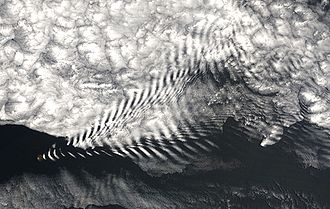
Orographic lift occurs when an air mass is forced from a low elevation to a higher elevation as it moves over rising terrain. As the air mass gains altitude it expands and cools. This cooler air cannot hold the moisture as well as warm air and this effectively raises the relative humidity to 100%, creating clouds and frequently precipitation.
Precipitation induced by orographic lift occurs in many places throughout the world. Examples include:
- The eastern seaboard of Australia, which faces prevailing easterly winds,
- The mountains of New Zealand, which faces a prevailing westerly flow off the Tasman Sea.
- The southern Andes, which faces a prevailing westerly flow off the Pacific Ocean.
- The Northwestern United States and Canada (Oregon, Washington and British Columbia) see prevailing westerly flow off the northern Pacific Ocean. Places on the sea-facing side of coastal mountains see over 100 inches (over 2.5 m) of precipitation per year. These locales are on the side of the mountains which are in the path of storm systems, and therefore receive the moisture which is effectively squeezed from the clouds.
5. Show with the help of a diagram how the earth's relationship to the sun produces the seasons.
 The Earth's tilt on its axis causes the seasons. When the axial tilt points a hemisphere away from the sun, it is winter, and when it points it towards the sun it is summer. This is not because the distance between that part of the Earth and the Sun varies, but rather, it is because the angle of the sunlight is either more direct, or less direct. The Earth's elliptical orbit about the sun causes its distance from the Sun to vary by a lot more than the axial tilt does.
The Earth's tilt on its axis causes the seasons. When the axial tilt points a hemisphere away from the sun, it is winter, and when it points it towards the sun it is summer. This is not because the distance between that part of the Earth and the Sun varies, but rather, it is because the angle of the sunlight is either more direct, or less direct. The Earth's elliptical orbit about the sun causes its distance from the Sun to vary by a lot more than the axial tilt does.
It is better to think of it this way: shine a flashlight on a piece of paper or cardboard. When the rays from the flashlight are parallel to the paper, the spot is circular. If you tilt the paper, the spot becomes elongated. The same amount of light strikes the paper in both cases, but the light is more concentrated in the circular spot verses the elongated spot. The area illuminated by the elongated spot is greater, so less light hits each square inch in the elongated "light spot". Less light means less heat, and in the case of the Earth, that means "winter".
6. What causes lightning and thunder? What different kinds of lightning are there?
Lightning
Lightning is caused when electrical charges build up in clouds. Scientists are still unsure exactly why that happens, but it is plausible that water droplets and ice travelling up and down within the cloud separate electrons from one another and transport them to the lower portions of the cloud. However this happens, it causes the cloud to have an electric field. When this field becomes strong enough, the electrons in the cloud begin to repel electrons on the ground, causing the ground to have a positive charge. When the voltage difference between the ground and the cloud becomes great enough, the air breaks down and actually conducts electricity. The air actually turns into plasma. When it conducts, the result is a lightning strike.
Many people mistakenly believe that the reason a car is a good place to be during a lightning storm is because the rubber in the tires insulates the riders from the ground. But considering the fact that a lightning bolt may have just travelled a mile though the air, how much do you think a quarter inch of rubber is going to slow it down? Not at all! The reason you are safe in a car is because you are surrounded by a metal shell that will carry the electrical current around you instead of through you.
Thunder
Thunder is, even today, not completely understood by modern science. The word usually describes a sonic shock wave caused by the rapid heating and expansion of the air surrounding and within a bolt of lightning. The bolt changes the air into plasma and it instantly explodes, causing the sound known as a thunder clap.
This phenomenon occurs at the same time as a lightning flash, but a thunder clap is usually heard after lightning is seen because light travels faster (300,000,000 meters per second) than sound (around 300 meters per second). In very close proximity to the lighting strike, sound and light can be heard and seen almost simultaneously.
Kinds of Lightning
Some lightning strikes take on particular characteristics; scientists and the public have given names to these various types of lightning.
Intracloud lightning, sheet lightning, anvil crawlers
Intracloud lightning is the most common type of lightning, and occurs completely inside one cumulonimbus cloud; it is termed sheet lightning because the bolt is not seen, instead one sees the whole cloud light up from inside. Lightning that appears to travel extensively along the cloud anvil or its base is commonly called a crawler, or sometimes 'spider lightning'. Discharges of electricity in anvil crawlers travel up the sides of the cumulonimbus cloud branching out at the anvil top.
Cloud-to-ground lightning, anvil-to-ground lightning
Cloud-to-ground lightning is a great lightning discharge between a cumulonimbus cloud and the ground initiated by the downward-moving leader stroke. This is the second most common type of lightning. One special type of cloud-to-ground lightning is anvil-to-ground lightning, a form of positive lightning, since it emanates from the anvil top of a cumulonimbus cloud where the ice crystals are positively charged. In anvil-to-ground lightning, the leader stroke issues forth in a nearly horizontal direction until it veers toward the ground. These usually occur miles ahead of the main storm and will strike without warning on a sunny day. They are signs of an approaching storm and are known colloquially as "bolts out of the blue".Cloud-to-cloud lightning
Cloud-to-cloud lightning
Cloud-to-cloud or intercloud lightning is a somewhat rare type of discharge lightning between two or more completely separate cumulonimbus clouds.
Ground-to-cloud lightning
Ground-to-cloud lightning is a lightning discharge between the ground and a cumulonimbus cloud from an upward-moving leader stroke. These thunderstorm clouds are formed wherever there is enough upward motion, instability in the vertical, and moisture to produce a deep cloud that reaches up to levels somewhat colder than freezing. These conditions are most often met in summer.
Heat lightning or summer lightning
Heat lightning (or, in the UK, "summer lightning") is nothing more than the faint flashes of lightning on the horizon or other clouds from distant thunderstorms. Heat lightning was named because it often occurs on hot summer nights. Heat lightning can be an early warning sign that thunderstorms are approaching. In Florida, heat lightning is often seen out over the water at night, the remnants of storms that formed during the day along a seabreeze front coming in from the opposite coast. In some cases, the thunderstorm may be too distant to hear the associated thunder from the lightning discharge.
Ball lightning
Ball lightning is described as a floating, illuminated ball that occurs during thunderstorms. They can be fast moving, slow moving or nearly stationary. Some make hissing or crackling noises or no noise at all. Some have been known to pass through windows and even dissipate with a bang. Ball lightning has been described by eyewitnesses but rarely, if ever, recorded by meteorologists.
7. Show with the help of a diagram what a convection is. What is its relation to winds?
A rising body of air typically loses heat because it radiates heat. At some point the air becomes more dense than the air underneath it, which is still rising. Since it cannot descend through the rising air, it moves to one side. At some distance its downward force overcomes the rising force beneath it and the air begins to descend. As it descends, it warms again through surface contact, conductivity, or compression, and the cycle repeats itself. (The heating through compression of descending air is what is responsible for such welcome winter phenomena as what is known in Western North America as a chinook wind or in the Alps as a Föhn wind.)
8. Explain how radar, satellites, and computers are used in weather forecasting.
Radar
A weather radar is a type of radar used to locate precipitation, calculate its motion, estimate its type (rain, snow, hail, etc.), and forecast its future position and intensity. Modern weather radars are mostly doppler radars, capable of detecting the motion of rain droplets in addition to intensity of the precipitation. Both types of data can be analyzed to determine the structure of storms and their potential to cause severe weather.
Satellites
A weather satellite is a type of satellite that is primarily used to monitor the weather and climate of the Earth. These meteorological satellites, however, see more than clouds and cloud systems. City lights, fires, effects of pollution, auroras, sand and dust storms, snow cover, ice mapping, boundaries of ocean currents, energy flows, etc., are other environmental information collected from weather satellites.
El Niño and its effects on weather are monitored daily from satellite images. The Antarctic ozone hole is mapped from weather satellite data. Collectively, weather satellites flown by the U.S., Europe, India, China, Russia, and Japan provide nearly continuous observations for a global weather watch.
Visible-light images from weather satellites during local daylight hours are easy to interpret even by the average person; clouds, cloud systems such as fronts and tropical storms, lakes, forests, mountains, snow ice, fires, and pollution such as smoke, smog, dust and haze are readily apparent. Even wind can be determined by cloud patterns, alignments and movement from successive photos.
Computers
Computers are largely responsible for the accuracy of today's weather forecasts. Various computers are used not only collect weather data from thousands of sensors around the world, but also for running weather simulations, and for presenting the information to the public on television news broadcasts.
Of these tasks, running weather simulations is certainly the most demanding. Numerical weather prediction models are computer simulations of the atmosphere. They take the analysis as the starting point and project the state of the atmosphere forward in time using an understanding of physics and fluid dynamics. The complicated equations which govern how the state of a fluid changes with time require supercomputers to solve them. The output from the model provides the basis of the weather forecast. There are a number of models that are used in forecasting, and each of them is a little different. Meteorologists look at the output of several and form their forecasts based on this.
9. Tell how the following can affect our weather:
a. Jet stream
Jet streams are fast flowing, relatively narrow air currents found in the atmosphere at around 11 kilometres (36,000 ft) above the surface of the Earth. They form at the boundaries of adjacent air masses with significant differences in temperature, such as of the polar region and the warmer air to the south. For this reason, areas between the pole and the jet stream are cold, and area between the equator and the jet stream are warm. As the jet stream shifts along the north-south direction, the weather shifts as well.
Meteorologists now understand that the path of the jet stream steers cyclonic storm systems at lower levels in the atmosphere, and so knowledge of their course has become an important part of weather forecasting. Jet streams also play an important part in the creation of super cells, the storm systems which create tornados.
b. Volcano eruption
When a volcano erupts, it sends incredible amounts of volcanic ash into the atmosphere. This is enough to decrease the amount of sunlight that reaches the earth, causing a temporary (though sometimes devastating) global cooling. It also affects the intensity of the colors in the sunset for years.
10. Make a drawing showing the water cycle in weather.
The water cycle is the continuous movement of water over, above, and beneath the Earth's surface. It is powered by solar energy, and because it is a cycle, there is no beginning or end. As water moves around in the hydrosphere, it changes state among liquid, vapour, and ice. The time taken for water to move from one place to another varies from seconds to thousands of years, and the amount of water stored in different parts of the hydrosphere ranges up to 1.37 billion km³, which is contained in the oceans. Despite continual movement within the hydrosphere, the total amount of water at any one time remains essentially constant.
11. Make a simple wind vane or rain gauge.
Wind Vane
A simple wind van can be made by fastening two sides of a strip of heavy paper around a short section of drinking straw. First, bend the strip in half. Place the straw in the bend and then glue the strip to itself. Drive a dowel, broom stick, or some similar item into the ground where you wish to measure the wind direction, and drive a finish nail into the top end. Then place the straw over the nail so that it may swing freely. When the wind blows, the vane (strip of paper and straw) will swivel on the nail indicating the wind direction.
Rain Gauge
A rain gauge is very simple to make. You will need a small, transparent vessel with constant diameter from top to bottom. If you have difficulty finding a vessel with constant diameter, you may opt to use a two-liter soda bottle. Strip off the label. Cut the top off the bottle, and fill it with plaster to a depth of 4 to 5 cm (this will provide a smooth bottom instead of the knobby bottom with which a two-liter bottle is typically endowed). You may wish to use epoxy instead of plaster - it is more expensive, but is more water proof. Plaster will work fine unless you plan to use the rain gauge for extended periods. You can also improve the water-resistance of the plaster by varnishing it.
Mark the sides of the vessel with a ruler, indicating millimeters and centimters, with the 0 mark coinciding with the bottom of the vessel's inside. Then set it outside where it can collect rain. When the rain ends, a quick comparison of the water level to the indicators will tell you how much rain fell. Empty the rain gauge between storms.
12. Keep a weather chart for one week and record readings at 12-hour intervals. Include the following:
a. Temperature
b. Moisture (dew, fog, rain, frost, or snow)
c. Cloud formation
d. Wind direction
You may need to call your Pathfinders every day to get them to do this. It may help to build the weather instruments from requirement 11 first to build some excitement about weather. It may also help to work on this honor during the season in your area that has the most extreme weather. You can download a tracking chart here and give one to each of your students. http://www.pathfindersonline.org/pdf/resources/weather_tracking_chart.pdf
If you are teaching this honor to a class of Explorers, there is a chart they can fill out in their diaries.

